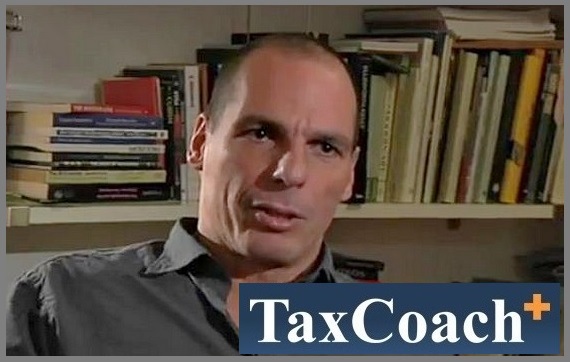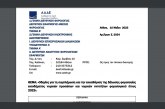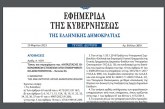
Ο απόηχος της ομιλίας του υπ.οικ., Γ. Βαρουφάκη, στο Συνέδριο Ambrosetti στο Κόμο στις 14/3/2015 και η ίδια η ομιλία, που ήταν εξαιρετικά ενδιαφέρουσα, όπως θα μπορέσετε να διαπιστώσετε στη συνέχεια.
Η συμμετοχή του υπουργού οικονομικών κ. Γιάνη Βαρουφάκη στο ετήσιο διεθνές Οικονομικό Φόρουμ Ambrosetti, στις 13-14 Μαρτίου, είχε ως αποτέλεσμα την παρουσίαση των θέσεων και της πολιτικής της ελληνικής κυβέρνησης σε ένα «κοινό» το οποίο παίζει αποφασιστικό ρόλο στην διαμόρφωση τόσο του επιχειρηματικού όσο και του πολιτικού κλίματος στην Ευρώπη και παγκοσμίως.
Ο Υπουργός παρουσίασε καινοτόμες προτάσεις για την αρχιτεκτονική της Ευρωζώνης, και πώς μπορεί αυτή να αναδιαμορφωθεί άμεσα εντός των συνθηκών και κανόνων που ήδη ισχύουν, σε 200 κορυφαίους εκπρόσωπους του πολιτικού, επιχειρηματικού, τραπεζικού και δημοσιογραφικού κόσμου.
Μετά από εισαγωγική ανάλυση της προβληματικής δόμησης της Ευρωζώνης, καθώς και των αντιδράσεων της Ευρώπης στην κρίση που ακολούθησε, ο Υπουργός παρουσίασε τις προτάσεις του για τον τρόπο που μπορεί να αντιμετωπιστεί η κρίση χρησιμοποιώντας τους υπάρχοντες θεσμούς και εντός των πλαισίων των υφιστάμενων κανόνων.
Ως παράδειγμα παρουσίασε εναλλακτική μορφή ποσοτικής χαλάρωσης, από αυτή που άρχισε να εφαρμόζει η ΕΚΤ, με επίκεντρο την Ευρωπαϊκή Τράπεζα Επενδύσεων η οποία, σε συνεργασία με το πρόγραμμα ποσοτικής χαλάρωσης της ΕΚΤ, μπορεί να αναδειχθεί στον πυλώνα ενός μεγάλου επενδυτικού προγράμματος, ενός «Ευρωπαϊκού New Deal», με στόχο τον τερματισμό του αποπληθωρισμού και την επιστροφή ολόκληρης της Ευρώπης στην πραγματική ανάπτυξη και χωρίς νέα δημόσια χρέη.
Τέλος, στην δευτερολογία του ο Υπουργός, απαντώντας σε ερωτήματα (καθώς και στην τοποθέτηση του τ. Πρωθυπουργού της Ιταλίας κ. Μάριο Μόντι), αναφέρθηκε στην διαπραγμάτευση και τους ευρύτερους στόχους της ελληνικής κυβέρνησης.
Αξίζει να σημειωθεί ότι η παρέμβαση του Υπουργού έγινε δεκτή με εγκωμιαστικά σχόλια από τους παρευρισκόμενους, κάτι που καταδεικνύεται και από ηλεκτρονική ψηφοφορία που έλαβε χώρα τόσο πριν όσο και αμέσως μετά από την παρουσίασή του. Χαρακτηριστικά, πριν την ομιλία του, το 41,3% θεωρούσε τις θέσεις/δράσεις της ελληνικής κυβέρνησης «κακές» ή «πολύ κακές» ενώ μόνο το 31,4% τις έκρινε «καλές» ή «πολύ καλές».
Όταν όμως η ψηφοφορία επαναλήφθηκε, μετά την ομιλία και δευτερολογία του Υπουργού, τα ποσοστά αυτά μεταβλήθηκαν ως εξής: Το ποσοστό που θεώρησε τις θέσεις/δράσεις της ελληνικής κυβέρνησης «κακές» ή «πολύ κακές» μειώθηκε από το 41,3% στο 31,7%, ενώ το ποσοστό που τις έκρινε «καλές» ή «πολύ καλές» αυξήθηκε από το 31,4% στο 47,1%. (Παράλληλα, το ποσοστό που δήλωνε ουδέτερη άποψη κυμάνθηκε στο 25,6% πριν την ομιλία του Υπουργού και στο 21,1% κατόπιν.).
Η ομιλία του υπουργού μας, είχε τίτλο “An agenda for Europe”.
Ακολουθεί ολόκληρη η ομιλία, στα αγγλικά:
An agenda for Europe
Back in March 1971, as Europe was preparing itself for the Nixon Shock and beginning to plan for a European monetary union closer to the Gold Standard than to the Bretton Woods system that was unravelling, Cambridge economist Nicholas Kaldor wrote the following lines in an article published in The New Statesman:
“… [I] Ιt is a dangerous error to believe that monetary and economic union can precede a political union or that it will act (in the words of the Werner report) “as a leaven for the evolvement of a political union which in the long run it will in any case be unable to do without”. For if the creation of a monetary union and Community control over national budgets generates pressures which lead to a breakdown of the whole system it will prevent the development of a political union, not promote it.”
Unfortunately, Kaldor’s prescient warning was ignored and replaced by a touching optimism that monetary union will forge stronger links between Europe’s nations and, following some large financial sector crisis, European leaders will be forced by circumstances to deliver the political union that was always necessary.
And so, at a time when America was recycling other peoples’ surpluses at a global scale, a Gold Standard of sorts was created in the midst of Europe, causing a wall of capital to flow into Wall Street fuelling financialisation and large-scale private money minting worldwide – with French and German rushing in to participate enthusiastically.
Within the Eurozone the illusion of riskless risk was reinforced by the fantasy that (in a union built on the Principle of Perfectly Separable Public Debts and Separate Banking Systems,) lending to a Greek entity was more or less equally risky as lending to a Bavarian one. As a result, net trade surpluses gave rise to net capital flows into the deficit nations, causing unsustainable bubbles in both the private and the public sectors. Our Eurozone growth model, ladies and gentlemen, relied heavily on private, bank-driven, vendor-financing for the net exports of the surplus nations.
It was as if, in constructing the Eurozone, we removed all shock absorbers while ensuring that the shock, when it came, would be massive. And when that massive shock came, in the form of the Great Eurozone Crisis in 2010, following the global Crash of 2008, with my country, Greece, proving the canary in the mine, Europe decided to remain in denial of the nature of the crisis, insisting on dealing with the insolvencies caused by the bursting of bubbles (first in the banking sector and then in the realm of public debt) as if they were mere liquidity problems, lending to the deeply indebted nations through SPVs (special purpose vehicles) that resembled stacked CDOs (collateralized debt obligations). The end result was a transfer of potential losses from the banks’ books onto Europe’s taxpayers in a manner that placed most of the burden of adjustment on the crisis countries that could least bear it.
The results of this unhelpful approach percolated for a couple of years in the bond markets, with almost catastrophic effects (nearly taking down Italy) that Mario Draghi dealt with courageously in the summer of 2012. Alas, that successful intervention, while placating the money markets, forced the crisis to metastatise to the realm of the real Euro Area economy, to an asymmetrical investment strike at a time when idle savings (the crisis’ other face) accumulated pushing yields down and causing a crisis of confidence that whipped up deflationary winds throughout the continent. Winds that Mario Draghi is, once more, called upon to quell through the long time coming policy of quantitative easing (QE).
Five years of crisis, and counting, damaged our social fabric and culminated in a Europe that has lost legitimacy with its own citizens and much of its credibility with the rest of the world. A Europe that is proclaiming greater union and consolidation in name while in practice its most acute problems are in fact being, regrettably, re-nationalised.
The Eurozone, ladies and gentlemen, remains in the clasps of an existentialist crisis, totally independently of Greece (if I may add), that is getting worse, not better. It is a challenge for all of us that neither fiscal rectitude nor Keynesian stimulus can meet. Remaining stuck in the sterile debates on whether budget deficits should be cut or increased by insignificant amounts, and by nations lacking a central bank, is as dangerous as it is tedious. This is why, it seems to me, the tussle between France and Brussels, or Rome and Brussels, over the minutiae of their budgets, and whether a few tens of a percent are shaved off or not, is totally besides the point.
Something else is needed: a different logic, a rational redeployment of existing institutions in order to attack the problem at its roots. While debt-deflationary dynamics eat away at Europe’s potential for shared prosperity, European governments are imprisoned by falsechoices:
• between stability and growth
• between austerity and stimulus
• between the deadly embrace of insolvent banks by insolvent governments, and an admirable but undefined and indefinitely delayed Banking Union
• between the principle of perfectly separable country debts and the supposed need to persuade the surplus countries to bankroll the rest
• between national sovereignty and federalism.
These falsely dyadic choices imprison thinking and immobilise governments. They are responsible for a legitimation crisis for the European project. And they risk a toxic democratic deficit all over Europe from which only nationalists, populists, separatists, anti-Europeans and, indeed, Nazis like our very own Golden Dawn may profit.
Now I know that, in this fine country of two brilliant Marios,[1] to utter these words as QE (i.e. quantitative easing) is being unleashed, borders on the blasphemous. QE is all around us and a great deal of optimism hangs on it. At the risk of sounding like a party pooper (as my daughter often calls me!), let me say that I find it hard to imagine how the broadening on the monetary base in our fragmented, and fragmenting, monetary union will transform itself into a substantial increase in private investment in productive activity.
QE has indeed proven quite bad at this transformation even in solid, homogenous economies like Japan, the US, Britain. It is bound to prove worse in a fragmented Eurozone where asset purchases by the ECB are not even proportional to output gaps or aimed at the national economies experiencing the most powerful deflationary forces. I very much fear that the decoupling of the monetary base from the money supply that is always QE’s Achilles Heel will, in the case of the ECB’s QE efforts, prove far worse than it did in the experience of Japan, the United States or Britain.
The German case illustrates this well. In 2015, Germany’s total bund issuance will come up to only €140bn, courtesy of the Federal Government’s attempt to deleverage. However, the ECB is committed to buying €160bn worth of bunds in the same year. At the same time, German banks must increase their regulator-imposed liquidity reserves by around €20bn. And they are only allowed to use highly liquid paper, i.e. bunds. This translates into an aggregate structural demand for bunds of at least €180bn for 2015, well ahead of supply.
Under such circumstances, German financial institutions have no incentive to sell bunds as they need them, and their relatively high yields, to satisfy regulatory requirements. Predictably, bund prices across the maturity spectrum will quickly head up towards the ECB’s stated maximum, yield spreads across the Eurozone will collapse independently of any investment-led recovery in countries like Spain and Italy, and share valuations will be inflated to levels that have proved unsustainable in the past.
The notion that this type of asset price inflation will help mobilise idle savings and convert them into productive investments, especially in the crisis countries, flies in the face both of empirical evidence from countries where QE was vigorously pursued previously and it flies in the face of basic macroeconomics.
In short, while the ECB is doing its best within the parameters it has been given, its ‘best’ is unlikely to be good enough. Something else is needed. Allow me to foreshadow what that ‘something’ might be. I call it a process of Decentralised Europeanisation. The long and the short of it is simple: We need to simulate a federal euro governance without federation, without further loss of national sovereignty, and under the existing Treaties.
Presently, Europe is sadly caught up in a false dilemma. On the one hand, there is the standard view that the way we are going in Europe today is leading us out of the crisis and it’s working. I don’t share that view. The other part of the false dilemma is to say that federation is the only alternative. I don’t think that is possible, and I don’t think it’s desirable, either. Thankfully there is a third option which I like to refer to as ‘Decentralized Europeanization’.
The idea is to Europeanise three or four basic realms of our political economies: Europeanise the banking sector, Europeanise a portion of the public debt, Europeanise aggregate investments (through the European Investment Bank and in association with the European Central Bank) and, finally, Europeanise a hunger and poverty alleviation program.
Once these realms are Europeanized, national governments can manage painlessly to run balanced budgets even if the external position of a country (like Greece or Portugal) is negative. For if aggregate investment, if the banking malaise, if a portion of the public debt, if a food stamp program are ‘Europeanised’, then our national governments can run balanced budgets while no one will even want to now whether Greece or Portugal have a current account surplus with Germany (just as no one in the United States knows, or cares to know, if New Mexico has a current account deficit with Texas).
As time is scarce, allow me to give only one example of this process of ‘Decentralised Europeanisation’. Of the four realms that need to be Europeanised (public debt, investment, banking and the humanitarian crisis) I shall concentrate on investment. The idea is simple:
• Europe desperately needs growth-inducing, large-scale investment.
• Europe is replete with idle savings too scared to be invested into productive activities, fearing lack of aggregate demand once the products roll off the production line.
• The ECB wants to buy high quality paper assets in order to stem deflationary expectations.
• The ECB would rather it did not have to buy German bunds or Italian or Spanish bonds for the reasons already mentioned or lest it be accused of favouring Germany or Italy or Spain etc.
Here is what the ECB could do to achieve its objective while overcoming both its ‘operational problem’ and the ‘macroeconomic concern’:
1. The European Investment Bank (EIB) should be given the green light to embark upon a Pan-Eurozone Investment-led Recovery Program to the tune of up to 8% of the Eurozone’s GDP, concentrating on large scale infrastructural projects while its offshoot the EIF concentrates on start-ups, SMEs, technologically innovative firms, green energy research etc.
2. The EIB has been issuing bonds for decades to fund investments, covering 50% of the projects’ funding costs. It should now issue bonds to cover the funding of the Pan-Eurozone Investment-led Recovery Programto the full; that is, by waving the convention that 50% of the funds come from national sources.
3. To ensure that the EIB bonds do not suffer rising yields, as a result of these large issues, the ECB ought to announce its readiness to step into the secondary market and purchase as many of these EIB bonds as are necessary to keep the EIB bond yields at their present, low levels.
The merit of this proposal is that, essentially, it recommends that the ECB enacts QE by purchasing a single asset; the solid, non-toxic, non eurobonds issued by the EIB on behalf of all European Union states. Thus, the ECB’s operational concern about which nation’s bonds to buy is alleviated. Moreover, the proposed form of QE backs productive investments directly, as opposed as to inflating risky financial instruments.[2]
One may counter that the EIB may have difficulty finding shovel-ready projects worth hundreds of billions of euros to fund to the tune of €200 billion per year. In the longer run this is not so. Worthy pan-European projects, such as the European green energy union, or the digital union, will offer the necessary investment opportunities to the EIB. In the meantime, existing infrastructure projects that are moribund because national budgets are exhausted could be funded by the EIB if the EIB knows that the ECB has its back in the bond markets. By removing some of the burden from national budgets, the current decline in public investment could be reversed creating, without additional public debt or fiscal transfers, thus inspiring private investors to ‘crowd in’.
A European Recovery Program of such magnitude would, suddenly, remind the EIB that it has the (hitherto unrealised) capacity to:
• become macroeconomically significant;
• to endogenise investment risk while reducing it; and
• to diminish the riskiness of the investment projects that it takes on simply through playing a larger role in Europe’s recovery
Conclusion
Europe’s future will be bright to the extent that we manage to use the euro crisis as an opportunity to bring about a United States of Europe. Anything less will lead to the fragmentation and eventual collapse of the euro (as Nicholas Kaldor had prognosticated in 1971) and the disintegration of the EU, with terrible consequences for Europeans.
However, while federation would have prevented this crisis, federating now is not a feasible solution to it. If anything, the euro crisis has, tragically, set one proud nation against another, making a ‘coming together’ politically impossible – for now. The current ‘difficulties’ we are facing within the Eurogroup, and the various stand-offs, are a reflection of political divergence caused by the crisis’ never ending ‘progress’.
Today I came to this fine venue to argue that what Europe needs is a solution to the current crisis that utilises, and re-deploys, existing institutions smartly and within the letter of current Treaties and rules.
I have presented one example of how this can be accomplished in the realm of aggregate, pan-European investment. The proposal for an EIB-ECB partnership (where the ECB performs QE by purchasing EIB-bonds in support of a large-scale investment-led recovery program) demonstrates precisely how Europe can mobilise existing institutions (in this case the EIB and the ECB), Europeanise aggregate investment, and lead to recovery without any need for Germany to pay for this program or for the productive investments that will flow into the deficit nations.
Come to think of it, what we have here is the potential for simulating a European New Deal without the need for a federal treasury, for any type of fiscal transfers, or for any new institution. While the richer nations, with Germany at the fore, will not need to pay a single euro toward this European New Deal, Europe needs leadership from surplus countries, like Germany, to bring this about.
In the early 1950s, the United States led Europe’s revivification with the Marshall Plan. It cost the American taxpayers 2% of GDP to transfer the necessary funds to Europe (money well spent even from an American perspective). The European New Deal will cost Germany, Holland, etc., nothing, since it will be funded through EIB-bond issues that, in fact, help mop up excess liquidity in Germany’s financial sector thus helping restore positive interest rates for German pension funds. It is my vision that Germany should lead the rest of Europe down this mutually advantageous path. Indeed, why not turn this into a legacy project that will, in decades to come, be known as the Merkel Plan. Such a development would help heal needless divisions and give European integration a much needed boost.
Today I only gave one example of Decentralised Europeanisation: aggregate investment. Similar solutions exist for Europeanising part of national debts, for unifying properly our banking sectors and for dealing with poverty and deprivation – without fiscal transfers, without deficit spending, without Germany footing the bill and, crucially, without loss of national sovereignty.[3]
Allow me to close with a heartfelt remark: The time has come to stop thinking of Europe’s recovery as a zero-sum game, where the interests of one nation are to be served by having some other nation pay. Europe has immense developmental potential which, however, requires an immediate paradigm shift within the existing Treaties and rules. Our generation has the duty to make that shift so that future generations can say that we enabled them to live in a truly united Europe; a Europe of shared prosperity in which being Greek or Italian or German is a cultural identity rather than a politically significant datum.
FOOTNOTES
[1] Here I was referring to Mario Monti (who was on the same panel) and, of course, Mario Draghi.
[2] Note that borrowing by the EIB has no implications in terms of European fiscal rules. It is recorded neither as new debt nor as a deficit for any of the member states, which means that new government spending could be funded without affecting national fiscal performance.
[3] Note that these ideas stem from the ‘Modest Proposal for Resolving the Euro Crisis’, co-authored by Yanis Varoufakis, Stuart Holland and James K. Galbraith
>>>•<<<
Ίσως σας ενδιαφέρουν τα ακόλουθα άρθρα:
✎ Που είναι ο Πούτιν;
✎ Ποιος θα υποχωρήσει πρώτα; Η Γερμανία ή η Ελλάδα; – Who will retreat first? Germany or Greece?
✎ Σκέψεις για τη νέα ελληνική κρίση
✎ Πρόγραμμα επιδότησης (έως 50%) για Υφιστάμενες επιχειρήσεις
✎ Πρόγραμμα επιδότησης (έως 100%) για ανέργους, για ίδρυση επιχείρησης



